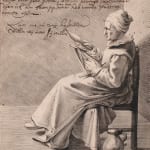Willem van Nijmegen (1636-1698)
Willem van Nijmegen was born in 1636 in Zaltbommel to a dynasty of artists.[1] He was an early specialist in grisailles for the decoration of interiors and well known for his imitations of marble. He also executed trompe l’oeil decorations in the form of landscapes appearing as engravings. From 1675 to 1690, Van Nijmegen was a member of the Guild of Saint Luke in The Hague, while he is also listed as a Guild member in Delft in 1684. From 1690 until his death on 12 October 1698, Van Nijmegen was active in Haarlem.
In spite of being a popular artist in his time, very few works are attributed to Van Nijmegen today. Some trompe l’oeil portraits of his predecessors Hendrick Goltzius and Rembrandt are in private collections, while a grisaille of Laocoön is in the Národní Galerie, Prague. The first known trompe l’oeil painting of a print was made around 1650 by Sebastian Stosskopff (1597-1657), now in the Kunsthistorisches Museum, Vienna, although it is unknown if Van Nijmegen was aware of its existence. Unique for his time is Van Nijmegen’s incorporation of the engraved medium while addressing himself directly to the viewer as in the present drawing.[2] It is no secret that the Dutch are known to be direct and the artist confirms this through his remarkable bravura.
Usually, the trompe l’oeil effect is accomplished by an engraving on a wooden panel; in the present Allegory of the loss of Arnhem, the drawing itself simulates a print. If not for the inscription, we would seemingly have a genre representation of a woman spinning yarn. However, the elaborated text explains that this work was created the day after the siege of the city of Arnhem by the French army. 1672 is known as the Disaster Year (‘Rampjaar’), when the Dutch Republic was under attack by the British and French armies as well as the dioceses of Cologne and Munster. Even in the unoccupied territories people lived with fear as banks, schools and courts closed. Artists and art dealers suffered during this crisis that bankrupted many.
Even in the unoccupied territories people lived with fear as banks, schools and courts closed. Artists and art dealers suffered during this crisis that bankrupted many. Knowing that Prince Willem III, Stadholder of Holland, had fled, the French Marshal, Vicomte de Turenne (1611-1675) gave the city of Arnhem an ultimatum. If the city refused immediate capitulation, its citizens would not survive. After vigorous resistance, the army surrendered on June 17. It is possible that Van Nijmegen was aware of Quast’s engraving published in 1652, depicting a peasant couple spinning yarn on a spindle with the devil in the background trying to unravel the spun thread.[3] In contrast to this earlier engraving, Van Nijmegen’s allegory is subtler; focused solely on the spinning woman, who is depicted not as symbol of virtue, but as the embodiment of the last sentence of the drawing’s inscription. The plea “Let us spin / we do not want: they want” indicates Arnhem residents’ desire to ‘let us be’ or leave us alone.
Shoes mules and boots
It all comes from the bull’s creature
Milk butter grass-cheese
It all comes from the young cow
It is unclear how the poem on the verso of the drawing relates to the fall of Arnhem.[4] Surrounded by sketches of coat of arms, the rhyme is likely to be related to Arnhem. Poems allowed an artist to comment very directly on current events. The comparison of products deriving from a bull or a cow could possibly indicate the equally important contribution of women and men, in this case in the defense against foreign invasion.
[1] Biographical information from: A. van der Willigen & F. Meijer, A Dictionary of Dutch and Flemish Still-life Painters Working in Oils, 1525-1725, Leiden 2003, p. 150
[2] A. Tummers, “The Painter Versus his Critics: Willem van Nijmegen’s Defense of his Art”, in: Aemulatio. Imitation, emulation and invention in Netherlandish art from 1500 to 1800. Essays in honor of Eric Jan Sluijter, Zwolle 2011, p. 438
[3] Dieuwke de Hoop Scheffer, “Een serie bedelaars door Pieter Quast: 'T Is Al Verwart-Gaeren'”, in: Bulletin van het Rijksmuseum, 1974, Vol. 22, No. 4, pp. 166-172. This print is possibly a satire on the English as indicated by its date of publication.
[4] Only one of the coat of arms is identifiable with the Van Welderen family crest. Johan van Welderen, lieutenant-general of the cavalry, in command of the nearby town of Nijmegen as of June, early July 1672 and Diederik van Welderen, nobleman of the county of Nijmegen, both defended their region in the battle against Turenne.



